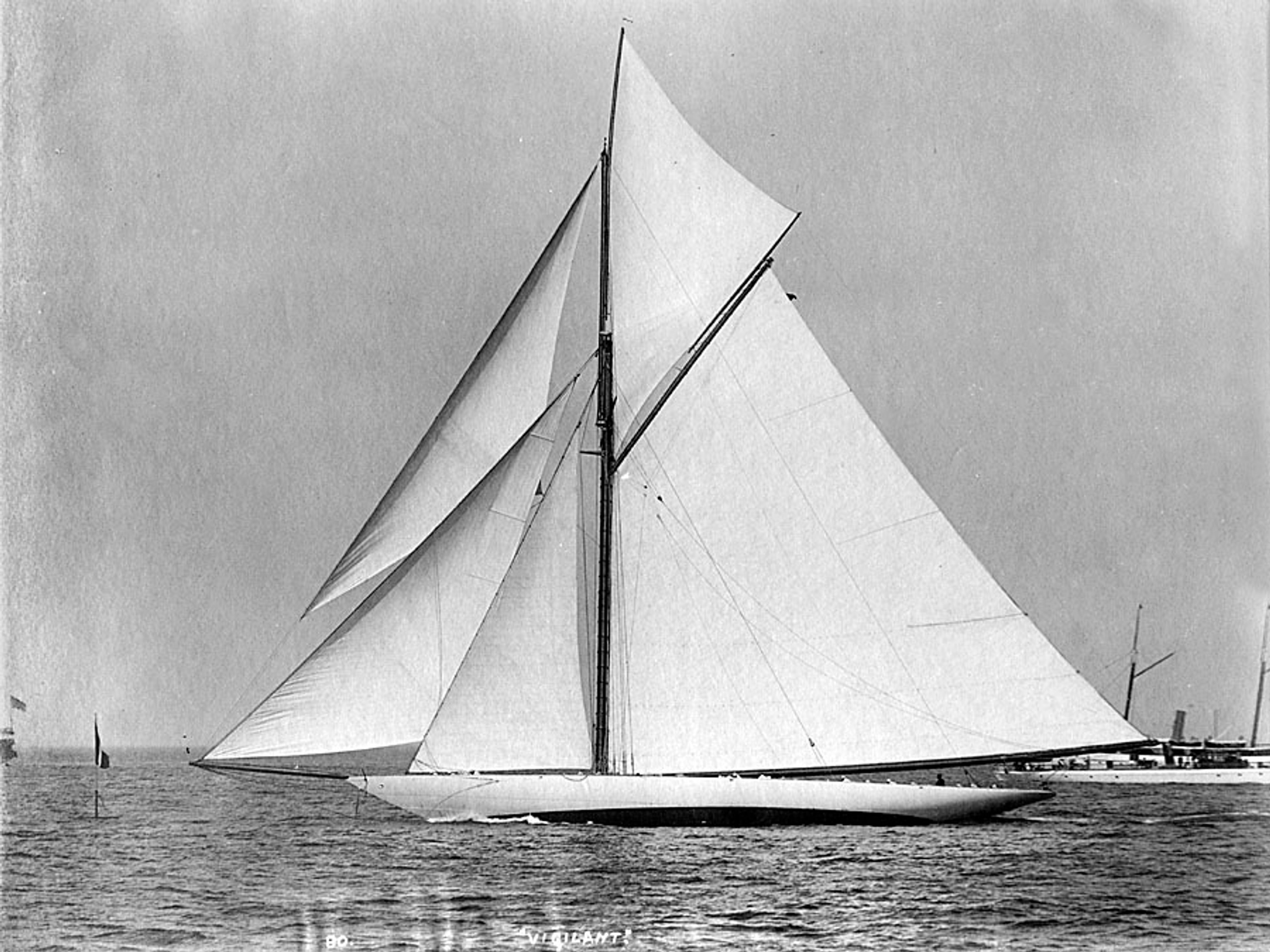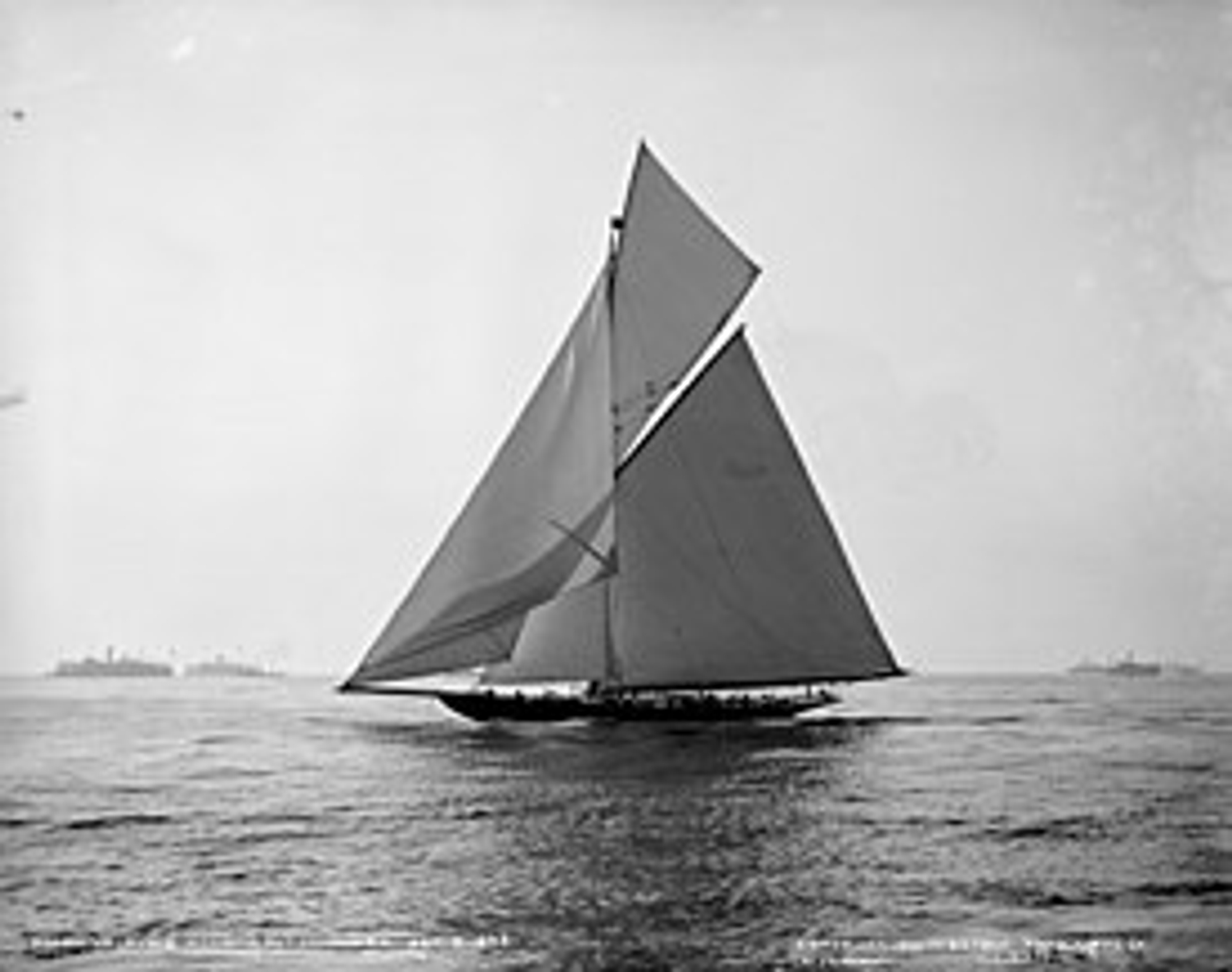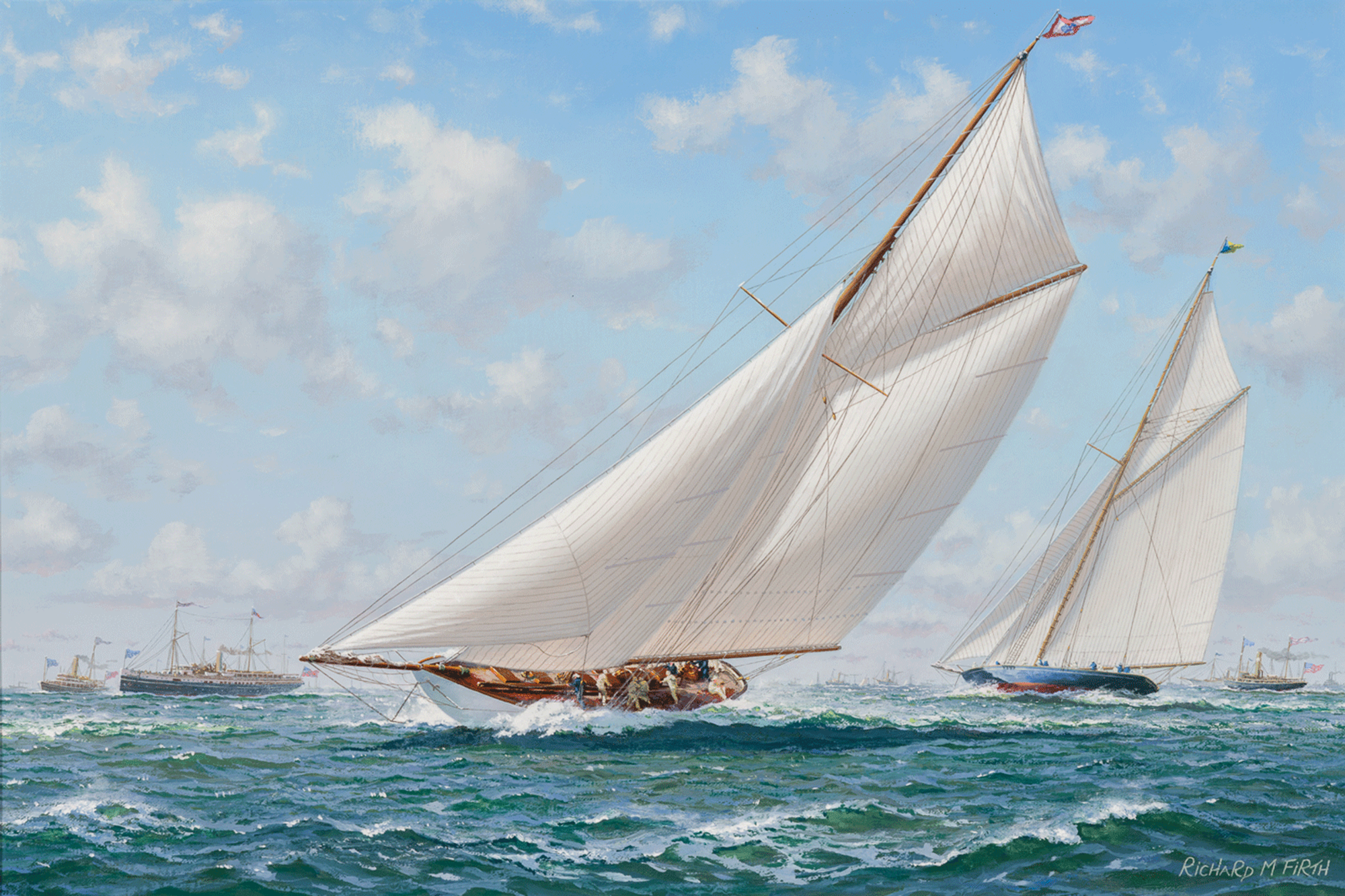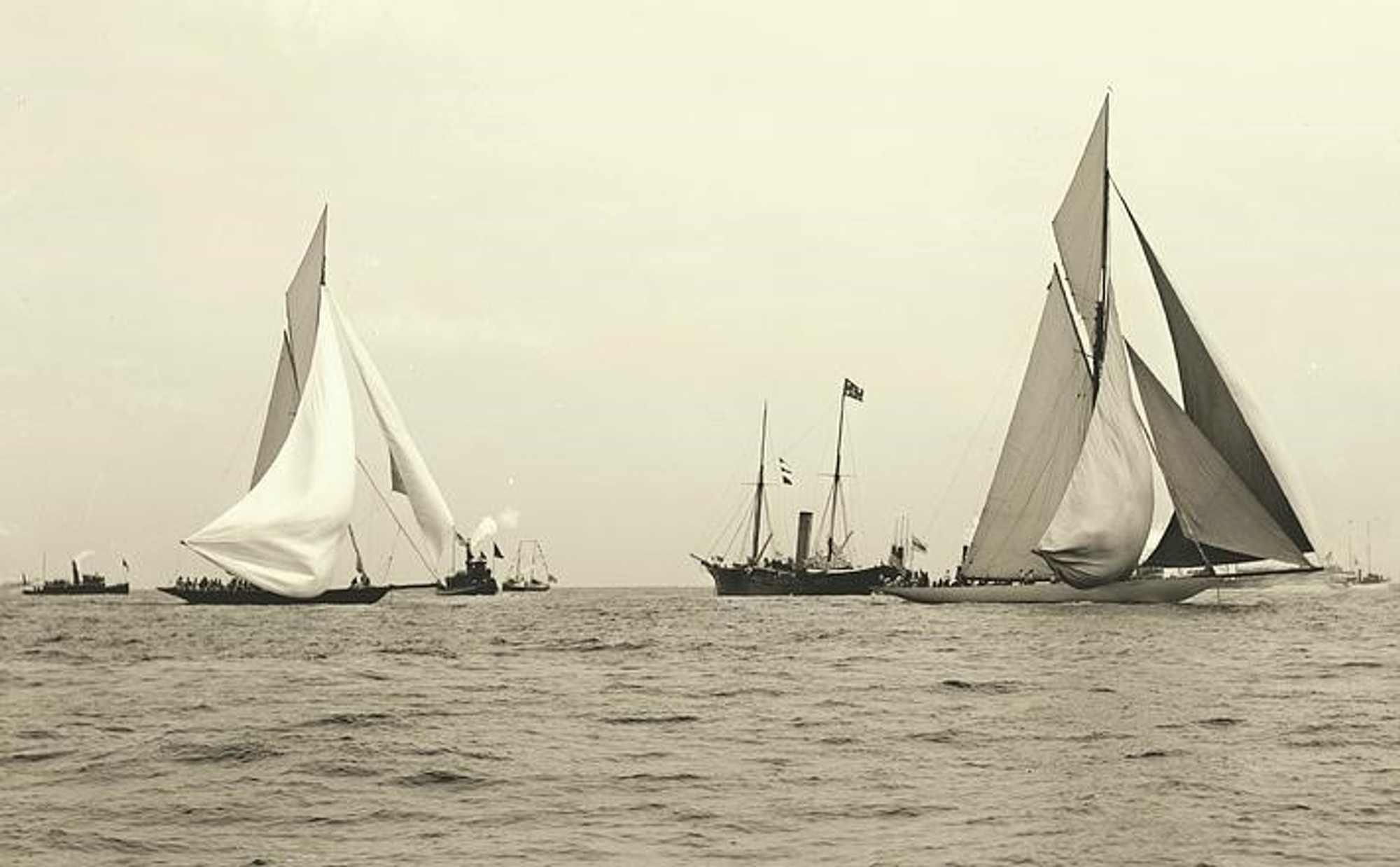DUNRAVEN RAISES THE BAR
Windham Thomas Wyndham-Quin, the 4th Earl of Dunraven and Mount-Earl, was anything but a shrinking violet and we enter a period of challenges for the America’s Cup that considerably raised the sporting stakes both on and off the water, and in doing so, elevated the profile and prestige of the event.
Challenging through the Royal Yacht Squadron following the issuance of the infamous and much debated 1887 Deed of Gift, the Lord Dunraven’s first challenge was received on the 19th March 1889 via telegram, sent from the Squadron’s secretary Mr Richard Grant. The British challenge was accepted on 11th April 1889 for the first ‘Valkyrie’, measuring in at 85 feet overall with a 15.9 foot beam, on the conditions laid out in the Deed of Gift to which Dunraven and a committee formed at the Royal Yacht Squadron vehemently opposed.
After correspondence between the two club’s America’s Cup Committees in the Spring of 1889, the Royal Yacht Squadron formally withdrew Lord Dunraven’s ‘first’ challenge stating in a concise letter that: “We would not undertake the responsibility of entering into such a covenant, which would make the terms of the new deed of gift binding on any future challenger. We would further point out that the effect of accepting the conditions of the New York Yacht Club would be to compel the Royal Yacht Squadron to insist upon receiving, should it be successful in winning the Cup, more favourable terms from a challenger than those under which it challenged.”
These words ‘caused a sting’ according to The Lawson History, at the New York Yacht Club and a reply was sent outlining that the ‘mutual consent’ governing matches was still applicable and that: “in the event of the Royal Yacht Squadron being successful in winning the Cup, it would not be compelled to insist upon receiving more favourable terms from the challenger than those under which it challenged.”
Lord Dunraven added further fuel to the fire of dissent the following April (1890), issuing a lengthy letter to Mr J.R. Busk of the NYYC rebuffing the club’s suggestion around ‘mutual consent’ and declaring that the 1887 Deed of Gift: “altogether too complicated a document to govern a matter of sport such as yacht racing.” Needless to say, the notion of a British challenge arriving in American waters that summer was dismissed as no common ground could be found and there was no further correspondence on Cup matters until September 1892, when Lord Dunraven again returned with a flurry of requests aimed at the NYYC committee.
Eager to get racing again for the America’s Cup, the NYYC accepted on December 5th, 1892, a long-worded challenge again issued from the Royal Yacht Squadron on behalf of Lord Dunraven that laid out key stipulations for an upcoming match in 1893. By prior agreement, a ten-month period was set for a five-race series as well as a concession that only the base load water-line dimensions would be submitted with a further caveat couched in time allowance for any deviation from the stated, challenging length upon measurement. Crucially, a final stipulation was that: “It is to be understood and agreed that, should the Cup come into the custody of the British Yacht Club, it shall be held subject to challenge under precisely similar terms as those contained in this challenge…”
With the clock now ticking, according to The Lawson: “American yacht designing never had a greater revival than that which followed the acceptance of the second Dunraven challenge.” And with the star setting of designer Edward Burgess, a certain Nathaniel G. Herreshoff of Bristol, Rhode Island came to the fore, designing two boats capable of a Cup defence namely: the Vigilant (centre-board) and the Colonia (keel-boat). Boston responded with two radical boats – the Jubilee and the Pilgrim – radical for their fin keels set on 90-foot yachts and the ensuing trials were a close run affair.

With such variance in design, each vessel had its day but by the end of the trails it was deemed that Colonia had trouble pointing into the breeze, Pilgrim’s deep keel flexed too much causing the same problem, and Jubilee’s lightly built deck gear (made of aluminium) and rigging was too fragile despite being a fast hull. Vigilant, having won all three trial races, was duly selected to meet the Valkyrie II challenge of Lord Dunraven.
Valkyrie II arrived late that summer having weathered Atlantic storms and just two weeks before the America’s Cup Match, leaving little time to work up her racing sails and rig. But she arrived with whispers that: “she was a demon in light airs and a very devil in a blow.” A composite steel and wood construction, from the design-board of George L. Watson, built at Partick on the Clyde by D.W. Henderson & Company, Valkyrie II measured in at 86.8 feet on the waterline and a beam of 22.33 feet and it’s recorded in The Lawson that: “she appeared heavier in hull and rig than the American boat, though smaller in beam, length and spars.”

The first race for the Cup was held in desperately light airs on the 5th October 1893 and was notable for the downwind start off a single gun-fire – an innovation not seen since the days of starts at anchor. Immediately Valkyrie II launched a spinnaker noted as being of “the most filmy lightness” with some thinking it be made of silk or Irish linen when in fact it was of unbleached muslin. But with a dying wind, and despite a massive lead of over 26 minutes to Valkyrie II, the race was abandoned with boats lying still on a glassy sea.
Coming back, two days late, on October 7th 1893, a windward/leeward course was set and again at the startline, Valkyrie II under the steerage of Captain William Cranfield, in breeze that barely rose above 6 knots bested the Vigilant and it was noted that: “barely a biscuit-toss of space separated them.” But wind luck, however, this time was reversed as Vigilant caught the first of a new breeze as the wind shifted abaft and with spinnaker set, she roared away from the British who put up a spirited fightback but ultimately lost after a thundering reach home in freshening breeze by 5 minutes and 48 seconds on corrected time.
If the crew aboard Valkyrie II were buoyed by their opening race performance, despite perhaps ruing their luck, the second race of the Match for the America’s Cup was a somewhat chastening affair. In a breeze that started at 10 knots and ended up at 29 knots on the 9th October 1893, it was conditions that the British thought were in their favour but were anything but. The Vigilant stormed the first leg in: “as stiff a thresh to windward under club top-sails as Cup racers need at any time” building a 4 minute 45 second lead that they simply extended through better seamanship and boat-handling all afternoon. By the finish, the Valkyrie II was some 12 minutes behind on the water and after corrected time was applied, 10 minutes adrift.
The disappointment of the second completed race, gave way however to one of the classics of the America’s Cup, a race at the time that was up there in notability as the final race between Genesta and Puritan. Ominously for the superstitious British yachtsmen, the schedule called for the boats to come to the start-line on Friday 13th October 1893 in a lumpy sea, overcast skies and heavy easterly wind blowing into Sandy Hook. In the pre-start, and actually at the appointed start-time, Valkyrie II had problems aloft as a sheave on one of her throat-halyards had been carried away. The race committee had generously postponed but by the time Valkyrie II was ready, the Vigilant was having difficulties in lowering her centre-board, stuck as it was in her box. The crew wrestled with the situation, eventually lowering to a depth of 11 feet, enough to get her to start. In the final run into the line, Captain Cranfield steering Valkyrie II’s big tiller secured a handy weather berth escaping from a lee position, a manoeuvre that was said to have won him: “golden opinions from the experts.”

Valkyrie II won the start by nine seconds and was making the best to weather, pointing higher as the wind built as the Vigilant had technical problems, losing a jib sheet and vital course position. In 25 knots of breeze and the lee rails submersed on both boats, Valkyrie II was proving the mettle of keeled yachts over centre-boards and without knowing it at the time, ushered in the demise of these yachts forevermore in the America’s Cup.
By the top mark, after a hard two hours of sailing, Valkyrie II rounded with a handy lead of a third of a mile and only a dead run to the finish left. Vigilant, realising that this was do-or-die, threw everything they had at closing the gap, unfurling the half-reefed mainsail, launching the No.2 club-topsail, hoisting the biggest spinnaker available alongside their balloon jib-topsail that jammed at half way causing men to be sent aloft to clear and hoist. Vigilant was thundering along “under a pyramid of rounded and hardened canvas” whilst Valkyrie II’s crew played relatively cautious as the lead boat despite launching their biggest spinnaker but deciding not to unfurl their half-reef in the mainsail and leaving the working-topsail aloft.
With the distances between the two boats closing, a squall filtered down the racetrack hitting the Vigilant first and: “she sped along at a pace she had never attained before, while everything held alow and aloft…” But for Valkyrie II, things didn’t go to plan as a small tear (or “rent” as it was officially described) that had been caused as the spinnaker was raised from the sail-locker “where it had got caught on the bitts,” widened, ripped and spread with a hiss across its width. The crew promptly exchanged the tatters for the light-weather unbleached muslin, so famed in the opening exchanges of the Match but again, as the sail was raised it caught on the cross trees and tore lengthways almost immediately. Still undeterred, the Valkyrie II crew brought up the balloon-jib used as a bowsprit spinnaker but with Vigilant now eked into the lead on the water it was too late to save the day.
Whilst the spectators on the excursion steamers “cheered themselves hoars”’ according to The Lawson, the Vigilant recorded a 40 second victory on corrected time, defended the America’s Cup for the New York Yacht Club and it was noted that this was: “a noble race, an expression of the highest development of the sport, such as comes but once in years.”
Lord Dunraven though was unhappy with his loss, examining each race in a wide-ranging (for the time) statement that he left for the press before leaving for England appraising each race and concluding that: “in our desire to conform to the eighty-five-foot limit, we sacrificed too much. We need not have been so sacrificing, for Vigilant was practically 87 feet long, and we should have increased the length of our boat. This would have helped us much. Further, we were greatly interfered by steamers, not being able to sail Valkyrie at times as we wanted to sail her…As a result I do not consider that the merits of the two boats have been determined.”
A second Dunraven challenge was almost a certainty…
READ MORE ABOUT THE 1895 EDITION: 'A TEMPEST IN A TEAPOT’ – DUNRAVEN’S 1895 CHALLENGE
